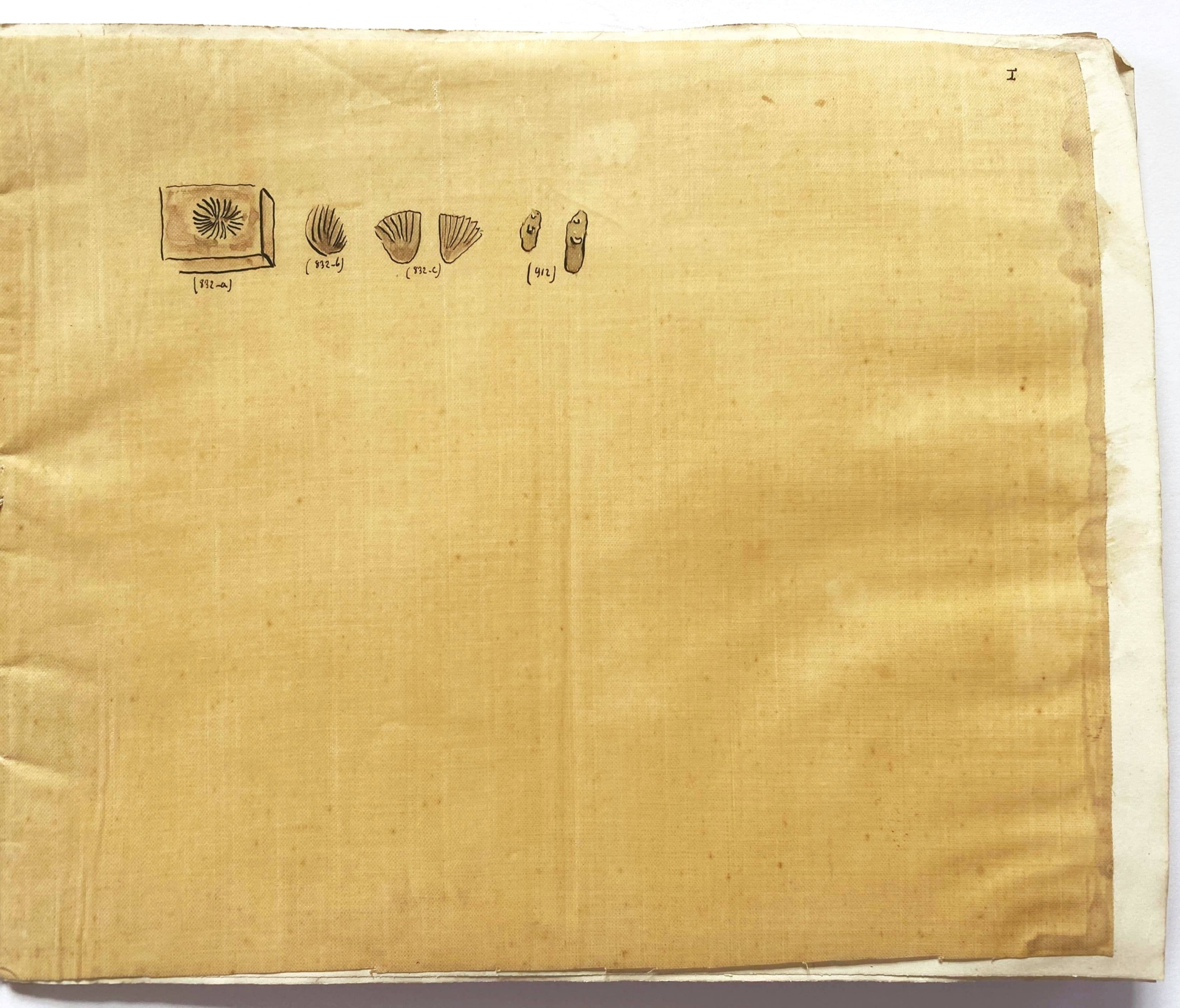BERAL, Eloi; Abdullah Bey – Collection of 3 manuscripts with over 600 watercolor and ink drawings of Devonian fossils in the Bosporus Strait from the collection of Abdullah Bey (Karl Eduard Hammerschmidt). Each drawing is numbered according to the corresponding specimen in the collection and includes the species name. The interesting aspect is that the specimens are not ordered by number, but by species/family.
Signed and dated (Constantinople, 22.09.1869) by Eloi Beral on one of the manuscripts. This is in various regards almost a manuscript catalogue of a part of Abdullah Bey’s extensive fossil collection. This collection is especially valuable as it serves as a testament to this part of his specimen collection, given that most of the geology collection from Istanbul and the Bosporus region has been lost due to multiple fires and a recent earthquake in 1999.
It includes drawings of fossils found in the following locations: Arnavutköy (Istanbul), Kuruçesme, Baltalimani, Rumeli Hisari, Kartal, Pendik, Kanlidja, Tchauchbachi, Yusa Tepe, Tchiboukly.
Abdullah Bey, originally Karl Eduard Hammerschmidt, (1800-1874) was an Austrian-born Ottoman scientist and physician. He specialized in mineralogy, geology, and fossil science.Engaged in the Vienna Uprising of 1848, Abdullah Bey sought refuge in the Ottoman Empire following its suppression, adopting Islam and the name „Abdullah“ upon arrival in Istanbul.
He represented the Ottoman government at the Paris Exhibition of 1867. He brought 3 collections to the Exposition Universelle: the first one, the one who contains the specimens included in our manuscripts, was formed of around 1200 Devonian fossils from the Bosporus region and earned him the gold medal of that year’s exhibition. At that moment, this was the greatest and largest fossile collection from Istanbul. Part of this collection ended up being gifted by Abdullah Bey to the Paris Natural History Museum. The other two collection were: one of entomology (for which he received another gold medal), and a herbarium of 20 leaves (for which he received the bronze medal).
In 1872, Abdullah Bey decided to donate another part of his collection of Devonian fossils from the Bosphorus area to the Cabinet of Natural History of Madrid, a collection now located in the „Museo Nacional de Ciencias Naturales de Madrid“. The reason for this was most likely his wish to foster international connections between museums. On the way from Turkey to Madrid, some parts of the shipment have been lost: most importantly, the inventory list of the specimens, but also 1 of 3 other publications regarding his collection, as well as – possibly – 26 plates with illustrations pertaining to one of the 2 publications that have been delivered. Other parts of his collection have been donated to museums in St. Petersburg, Italy and Austria.
He is unanimously considered a pioneer in the ares of Turkish geology, entomology and paleontology, having first introduced the terms and concepts of geology to Turkey. Geological mappings and findings in Turkey were scarce and significantly delayed. The first crude geological map of the city was created by French entomologist Guillaume-Antoine Olivier in 1801. The second geological map, produced by Philippe Edouard Poulletier de Verneuil, appeared in 1837, while the first modern colored geological map was made years later by Russian Prince Piotr Alexandrovich de Tchihatcheff (1856-1869). This highlights the significance of Abdullah Bey’s contributions, as his work provided crucial insights into an area that, at the time, was largely geologically unexplored.
At the Imperial School of Medicine in Istanbul. in 1871, the Ottoman Empire inaugurated its first natural history museum under the name ‚Le Musée d’Histoire Naturelle d’École Impériale de Médecine de Constantinople‘. Dr. Abdullah Bey facilitated the transportation of thousands of samples to Istanbul through his collaboration with European naturalists. Not only did he establish a prestigious museum in the Ottoman Empire, but he also cemented his place in history as a pioneer of one of the most significant impacts of the French Enlightenment on scientific endeavors within the Islamic world.
After Abdullah Bey’s sudden death in 1874, the museum’s activities slowed, and the collection was moved to Istanbul University’s Geology Faculty. Unfortunately, the collection was destroyed in the Vefa Fire of 1918, leading to the permanent loss of Istanbul’s only natural history museum.
Éloi Béral (1838-1908) was a French engineer and politician. After graduating from the École Polytechnique, he became a mining engineer in 1861 and later served as the prefect of Lot. Although unsuccessful in his initial bid for a legislative seat in 1877, he eventually became a senator in 1883, focusing on mining issues. In 1869, as noted in one of these notebooks, Eloi Beral was sent on a mission to the Ottoman Empire. During this assignment, he explored Abdullah Bey’s collection of Bosporus fossils and created drawings of the exhibited specimens.
—
-„Fossiles Devoniens de la rive droite du Bosphore / Arnautkeuy – Kourou-Tchesme – Bebek – Balta Liman (801 a 850) et (901 a 979) Roumely-Hissar (877 a 890)“. 93 drawings on 8 sheets [ca. 15 x 18 cm.].
Species included: Cryphoeus, Eulima, Loxonema, Eronyptalus, Pterinoea Pentamerus Cerebratula, Pterina, Bivalve, Spirifer, Orthis, Leptoena, Strophonema.
—
– „Fossiles Devoniens des Rives de la Mer de Marmara a Kartal et Pandyk comprenant les n.os 980 a 1190“. (Constantinople, 22. 09.1869). 165 drawings on 9 sheets [ca. 15 x 20 cm].
Species included: Phacops, Cryphoeus, Ortoceras, Rhynconella, Calyptroea, Cerebratula, Spirifer, Orthis, Leptoena.
—
– „Fossiles Devoniens de La Rive Gauche du Bosphore – Kanlidja – Tchauch-bachi – Tchiboukly (1 a 800), Mont Geant (831 a 876)“. 355 drawings on 14 sheets [ca. 18 x 22 cm].
Species included: Phacops, Cryphoeus, Pterinoea, Cerebratula, Spirifer, Pirifer, Cyrthia, Flabella, Orthis, Streptorthyncus
EUR 5.500,-














































